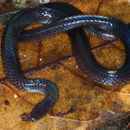en
names in breadcrumbs


Calamaria is a large genus of dwarf burrowing[5] snakes[6] of the family Colubridae. The genus contains 66 recognized species.[7] The genus is endemic to Asia.[8]
Species in the genus Calamaria share the following characteristics. The eight to 11 maxillary teeth are subequal; the anterior mandibular teeth are somewhat longer than the posterior ones. The head is not distinct from neck; the eye is small, with a round pupil; the nostril is pierced in a minute nasal scale. No loreal, internasal, or temporal scales are present; the preocular can be present or absent; the parietals contact the labials. The body is cylindrical, with smooth dorsal scales, without apical pits, in 13 rows. The tail is short; the subcaudals are paired.[9]
The following 67 described species in the genus Calamaria are recognized as being valid.[4]
Nota bene: A binomial authority in parentheses indicates that the species was originally described in a genus other than Calamaria.
Calamaria is a large genus of dwarf burrowing snakes of the family Colubridae. The genus contains 66 recognized species. The genus is endemic to Asia.